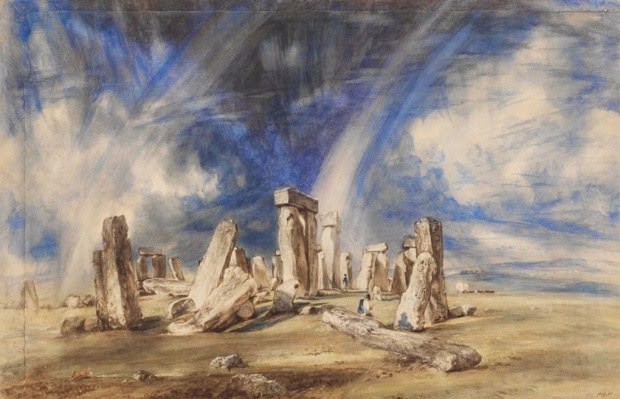Within the last three years, London’s gallery-goers have had the chance to see retrospectives of the three German artists who are regarded as the most significant since the Second World War. Tate Modern showed
Gerhard Richter in 2011 and now it has
Alibis: Sigmar Polke while the Royal Academy is offering
Anselm Kiefer. I’m not sure that the RA has used the term “retrospective” to describe their show, and if they haven’t it was a wise choice, because significant pieces of Kiefer’s work are monumental installations fixed elsewhere. Anyone visiting the exhibition should find the recent Alan Yentob
programme in the BBC1 imagine series a valuable complement to the RA exhibition because it reveals the scale of the works which remain in Kiefer’s workshops in Germany, southern France and near Paris. As it is, the canvases and installations, some made for this show, fill the RA’s rooms to capacity.
Kiefer was born in 1945 and he emerged as an artist in the late 1960s with
Occupations, a series of photographs of the artist performing the Nazi salute while wearing his father’s military uniform. The image appears in
Heroic Symbol V (1970,
Heroisches Sinnbild V, below):
Landscape is a recurring theme in Kiefer’s work, for example
Winter Landscape (1970,
Winterlandschaf, below top) and
Black Flakes (2006,
Schwarze Flocken, below lower):
And so is German history. Kiefer grew up in Germany in the aftermath of the Second World War and his work continues to address this period in works like
Operation Sea Lion (1975,
Unternehmen Seelöwe,
the planned invasion of the UK in 1940, below top),
Interior (1981,
Innenraum), below middle, the ruins of Speer’s New
Reich Chancellery in 1945) and
Morgenthau Plan, (2013, bottom and detail in the poster above,
the US plan for “converting Germany into a country primarily agricultural and pastoral”):
Other recent works at the RA are concerned with the
Atlantic Wall and the
Siegfried Line. Inevitably Kiefer has addressed the Holocaust in his work, notably through the poetry of Paul Celan, a Romanian survivor of the camps. His poem
Death Fugue (
Todesfuge) which ends '
Tod ist ein Meister aus Deutschland' ('Death is a master from Deutschland') compares the blonde Margarete and the dark–haired Jewess Shulamite. For
Margarete (1981, below top) Kiefer attached yellow straw to a painting of ruined fields, and
Shulamite (1983, below lower) is printed over an image of the Nazi Funeral Hall for the Great German Soldier, built in Berlin.
Kiefer’s wide interests in history and philosophy are given expression in works like the massive (2.9 x 5 metres)
Ways of Worldly Wisdom: Hermann's Battle, (1980
Wege der Weltweisheit: die Hermannsschlacht, below). This is one of several works of similar titles and which require a
Neil MacGregor on hand to explain the full significance of the images Kiefer chose to include:
Personally I find Kiefer’s enthusiasm for alchemy and other mysticisms difficult. His preoccupation with lead in terms of “texture, colour, strength and malleability” to quote the RA’s
Gallery Guide is understandable but:
He believes it is the only material heavy enough to carry the weight of human history, and that its properties most closely resemble ours. ‘It is in flux. It’s changeable and has potential to reach a higher state of gold.’ This reference to alchemy, the transformation of base metals into gold, a subject that fascinates Kiefer, is perhaps a metaphor for the way his art attempts to transform and redeem the past.
Well perhaps, and better lead than uranium, denser and with a fissile isotope. Lead certainly makes impressive sculptures, overbearing even. For example, installed at the entrance to the show,
Language of the Birds 2013:
Equally striking are the contents of the vitrines in the RA courtyard,
Velimir Khlebnikov: Fates of Nations: The New Theory of War. Time, Dimension of the World, Battles at Sea Occur Every 317 Years or Multiples Thereof, Namely 317 x 1, 2, 3, 4, 5, 6 . . . . . . . ., 2011-14, though Kiefer is
on record as saying that Khlebnikov’s ideas are “complete nonsense”:
Specifically for the RA, and occupying the whole of Gallery 7, is
The Ages of the World (2014, below), an installation with a strong geological metaphor –the word ‘Devon’ in one of the accompanying paintings
indirectly referring to SW England:
Towards the end of the exhibition, and in marked contrast, are “books” by Kiefer, one-off folios might be a better description, containing among other things some fairly graphic erotica. The
Gallery Guide explains their derivation from similar pieces by Rodin, but possibly there is a link to Schiele’s nudes (currently in London
at the Courtauld Gallery).
Anselm Kiefer ends at the RA on 14 December.














































